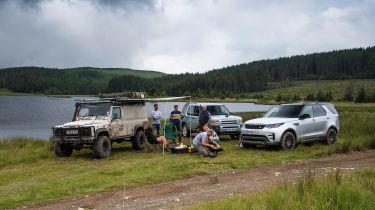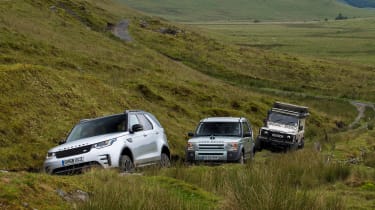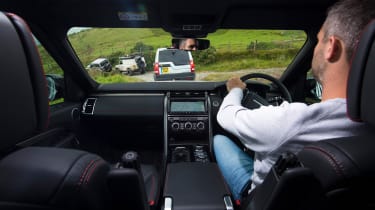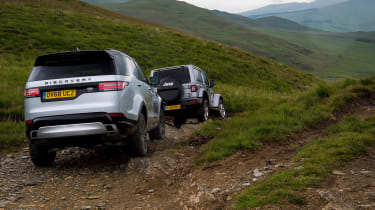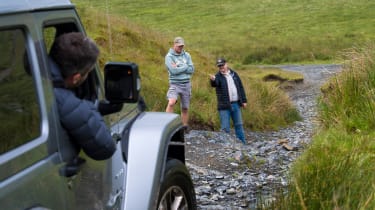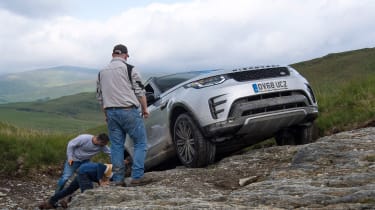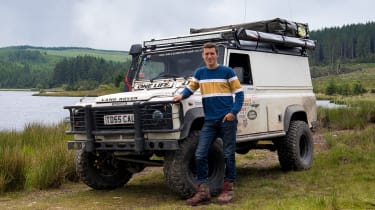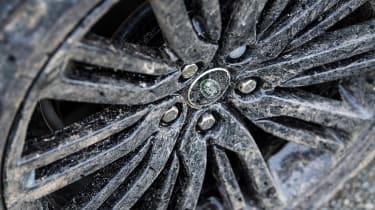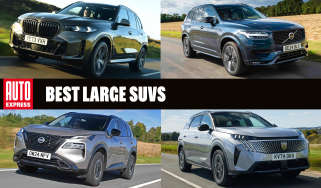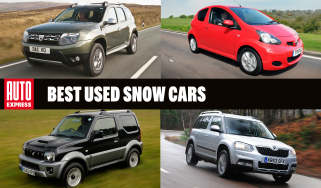Green laning: driving off-road in the UK
There are miles and miles of green lanes to explore up and down the country, so we join a GLASS guide for a true off-road adventure
Before the Natural Environment and Rural Communities (NERC) Act came into force in 2006, the number of public byways (BOATs) and unclassified roads (UCRs) dotted around England and Wales stood at more than double what it does today.
Once you’ve got your head around the acronyms, it’s still possible to find clusters of these ‘green lanes’ up and down the country. They can be as little as a hundred metres long or could run for several miles – taking in anything from broken tarmac to deep streams and precarious rock crawls.
In recent years, however, green-laners have been the subject of much-unwanted attention and bad press, despite their activities being completely legal. To find out a bit more, we took a trip to mid-Wales with veteran Green Lane Association (GLASS) member and serving police officer Stewart Pickering for a spot of light off-roading.
Pickering came across the idea of green-laning over a decade ago after suffering a slipped disc in his back. He’d always loved hiking and the outdoors, but the idea of putting on a backpack and heading for the hills was, in his own words, “an absolute no-go”.
“At the time I had a [Land Rover] Freelander, and a mate of mine had a Nissan X-Trail,” Stewart told us. “We were out and about one day and bumped into a National Trust ranger, who gave us a few pointers on where to go.
“We did it, and we loved it,” he said. “With access to the right information, you don’t need to be a rocket scientist to plan and research routes yourselves.”
Details on local green lanes are obtainable via your local council’s Rights of Way department, and are marked on every Ordnance Survey map. Over the past decade, Stewart has also spent thousands of hours adding to the Trailwise database. Access to this is granted via GLASS membership (£48/year), allowing users to plan routes and access real-time maps with their smartphone.
Pickering has owned a number of 4x4s over the years, including a Land Rover Discovery that he rebuilt using various heavy-duty parts. The ambition was to take it over to Morocco for the adventure of a lifetime but, while that trip never happened, it was clear before long that our man had caught the off-road bug.
Some of the people he now green-lanes with favour the Toyota Land Cruiser or Mitsubishi Shogun, but it’s the Land Rover fan boys (or girls) and the die-hard Jeep owners that make up much of the pack. Stewart did the unspeakable a few years back: he ditched his Disco for an old Wrangler. Understandably, then, he’s particularly taken with the new two-door Sahara model that we’ve brought along.
The morning begins just a few miles outside Aberystwyth, at an unassuming visitor centre tailored for ramblers, runners and adrenaline-seeking mountain bikers. We’re joined by Patrick Cruywagen, editor of Auto Express sister title Land Rover Monthly, as well as two of the industry’s biggest media influencers. Callum Wallis-Otter spends almost every weekend green-laning. He’s had his ex-water board Defender for four years, heavily modifying it with things like a two-inch lift, axle breathers and a snorkel; its TD5 diesel engine has been remapped to develop just shy of 200bhp, too. On the flipside, Nicholas Euston’s Discovery 3 is completely standard – not that his 134,000 Instagram followers seem to mind.
The final car on our trip is one of our favourites and the latest in Land Rover’s illustrious lineage of go-anywhere 4x4s. Our fifth-generation Discovery was fitted with the top-selling TDV6 diesel engine and all the electronic gubbins one could hope for, so there should be no slope too tough for the 2017 Auto Express Car of the Year.
“We’ll have to be careful,” Stewart says tentatively. “It’ll be very easy to catch those huge wheels and tyres”
As we set off from the visitor centre, Stewart jumps from the passenger seat of the Wrangler and directs us down a narrow tarmac path towards a closed gate. It looks like an opening to a farmer’s track, flanked by moorland that appears dramatically inhospitable because of the looming morning fog.
We pass through, one by one, immediately faced with a fork in the road. Both directions quickly become unpaved, rocky tracks without the usual 30mph signs or location markings you’d find out and about. We take the left fork and start climbing the rutted route towards a clearing.
Knowing the green-laning language is important. Unclassified roads are called UCRs, and are sometimes paved and sometimes not. A BOAT is a ‘byway open to all traffic’, and will generally pose a tougher challenge. Often unsurfaced, BOATs are frequently passable only in off-road 4x4 vehicles, although to begin with our chosen route appears as though it’d be easily negotiable even in one of the more modest road-biased ‘school run’ SUVs. As we dip down to the valley floor, though, the lane narrows and the rocks become both more slippery and sharper.
Of course, if you’re going to go green-laning, there are a number of rules you need to follow. Rather than nannying or preaching to its members, GLASS offers a simple code of conduct, which Stewart talks us through at various points.
The guide says anyone using BOATs or UCRs must ‘keep to the defined track’, and ‘detour only to pass immovable obstructions.’ They are words Stewart reiterates as we switch positions, ensuring that we wait for a clearing or a wider section of road to alter the order of our convoy.
The code also touches on the troubles that have been faced by GLASS members in recent years: ‘Use only rights of way with known, proven, or provable vehicular rights’, it says. ‘If challenged, discuss. If not resolved, leave as requested until status has been rechecked.’
There have been instances where otherwise-passable lanes have been littered with nails or other debris to dissuade off-road enthusiasts like Stewart from using these legal rights of way. “The [unsavoury] actions of an individual can reflect upon the actions of others,” Stewart tells us. “Using common sense is key; driving around an obstacle is one thing, but ploughing through someone’s fence to pass a fallen tree isn’t acceptable”.
The routes we’re using are all open to the public, so every vehicle must be road legal. GLASS recommends keeping to groups of four or less, but Stewart suggests that going alone is asking for trouble. In areas like this, the phone signal is sporadic, so back-up is essential.
As our route gets progressively more precarious, Stewart recounts stories of how he and his friends have uncovered routes that hadn’t been used for 10 years, or tracks they’d found with a slain 4x4 rolled to one side. Safety is his number one priority, emphasising that slow and steady wins the race.
After a couple of photo opportunities and an entertaining run through a fast-flowing stream we stop for lunch, which seems as good a time as any to chat with Nicholas and Callum, who both quite obviously fall on the Land Rover side of the fence. When Callum passed his driving test four years ago, instead of saving up for a Ford Fiesta or Volkswagen Polo, he said to himself: “I don’t want a car. I want a Land Rover.”
He’s since modified his Defender 110 into a barely recognisable 4x4-cum-camper with an awning, bed, and custom race seats up front for greater comfort. Callum has also fixed a light bar to the roof, which he claims “turns night into day”.
Nicholas grew up with Land Rovers and, because his Discovery has proved so reliable, he’s reluctant to make many changes: “I’ve had 116 [yes, really] Land Rovers,” he tells us. “You just get so much car for the cash.”
As we return to base, we realise that we haven’t seen another car for seven hours. While we agree there’s still plenty to enjoy about throwing on a pair of walking boots for a hike up a hill, there’s no denying our day out has opened up an exciting world that, with preparation, could uncover a totally new way of exploring the countryside.
This may have been our first green-lane adventure but, thanks to GLASS’s insight, it certainly won’t be our last.
Green lane top tips
- 1. Join GLASS for access to Trailwise – the biggest and most up-to-date green-lane database. Adding comments improves the service for other members, too.
- 2. Do your research: stick to official routes and marked byways, and remember to be courteous to other users.
- 3. Try to travel in convoys of fewer than four. Never green-lane alone – you could end up stranded for ages.
- 4. Make sure you know your limits and your vehicle’s limits. Your car must be completely road legal: taxed, insured and with a valid MoT. Tow ropes are always useful, too.
- 5. Leave the countryside as you would wish to find it. Take nothing but photos, and leave nothing but tyre tracks!
Fancy going green laning yourself? Then why not check out our list of the best 4x4s to buy here...
Find a car with the experts

